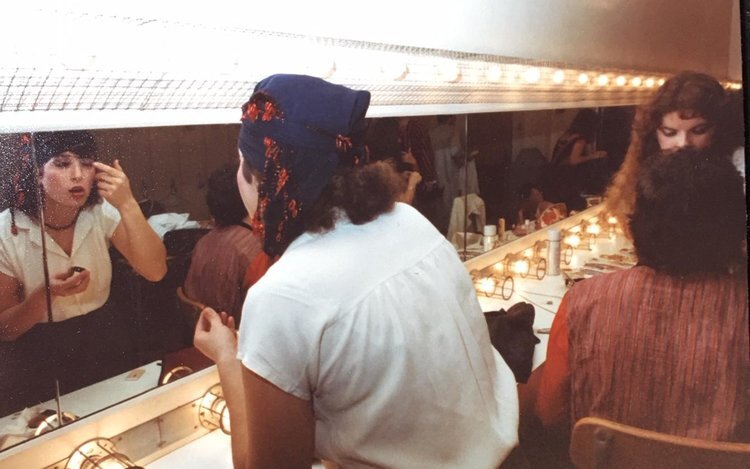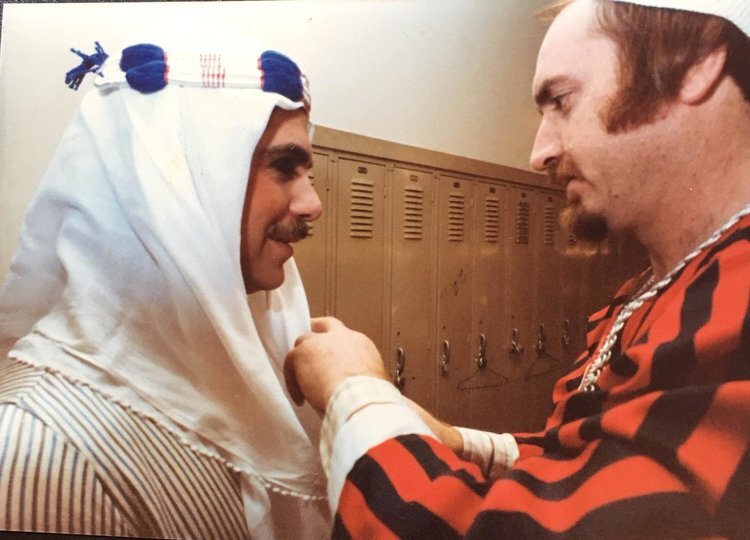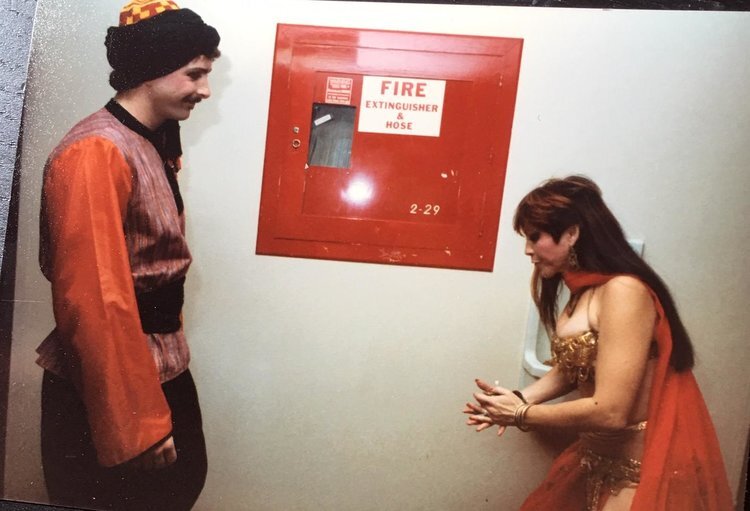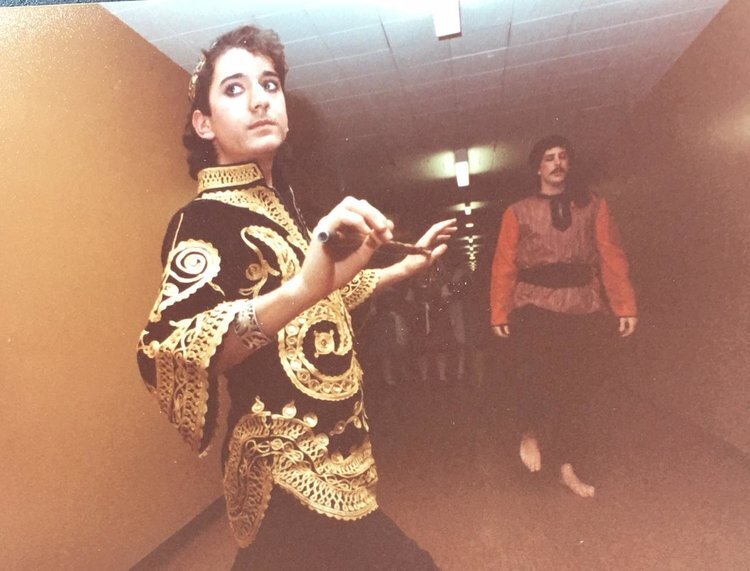Last night we had a rehearsal in my studio for the upcoming 2019 San Francisco Ethnic Dance Festival http://worldartswest.org/main/schedule.asp We’re planning on doing a recreation of a Beirut Nightclub. Rehearsing were Jeanette Cool our manager with Georges Lammam, Susu Pampanin, Hash Abdel Hadi, Nicole Maria Hoffschneider Cao, Mohini Rustagi Vora and me, Amina Goodyear. MIA were L'Emir Hassan Harfouche, Khader Keileh, Terrianne Gutierrez and our fans the make-believe nightclub clientele. That’s a lot of people to coordinate schedules and a lot of last names to put on the EDF program for just a ten minute spot. Next time we'll practice in a larger studio to accommodate the rest of the players
Jeanette was talking about how the artists and administrators in the various arts agencies in the city remain loyal to their passions but sometimes crossover from one arts organization to another. While some move around and change agencies and panels, other have remained true to the same, year to year, decade to decade. Founded in 1978 The Ethnic Dance Festival has been in existence over 40 years and has seen this loyalty - coming and going according to life’s dictates but always returning. They were founded when my group the Aswan Dancers was only two or three years old and I certainly can attest that personnel can move around a lot through the years of operation, but really they may just continue in a different capacity. Such as I guess I’m the only one left of the original Aswan Dancers. Susu has always been around but since she was just a kid, she didn’t really get involved in the group until a bit later and like some other core members of the Aswan Dancers would come and go depending on life’s other commitments. And so, just like the EDF we’re still here and still performing.
The Aswan Dancers have gone through many different dance configurations. We first started in 1975 when the SF Public Library asked me and my group to present a show. It was a case of speak first, say yes and then worry about the problem later. The problem was — I didn’t have a show or a group. So…I gathered together all the dancers in my classes, all the best and all the rest, and we worked on choreography. At that time “choreography” was an unknown word in my vocabulary but it was so very necessary for group dances. The girls who were trained to improvise as soloists to work in clubs with musicians were pretty enthusiastic to learn something new so we had a great time working on “choreography.” We started with two lines and worked on creating formations and floor patterns while being unpredictable. Being unpredictable and not classroom square - square meaning four of this and four of that, go to the right, go to the left, don't leave you spot in the line - was something I learned not to do from Mahmoud Reda, Fatma Akef and other Egyptian dancers I studied with. I learned spacing, to be unpredictable and controlled chaos from them. The night of our debut at the library we were ready and hot to burn the house down with all our talent and enthusiasm. Bellydance was a new dance form in the 70's so we had quite a few curious onlookers. In fact, we had a standing room only audience. Men, women and lots of children filled the chairs and the room, were crammed between the stacks and were even hanging on the bannister rails up and down the staircases. We were a huge success and we hadn't even started. I must admit that although it was a pretty memorable occasion, I quickly made a mental note to fire myself from being a group dancer. I couldn't do choreography. When the the girls went left, I would go right, when they turned right, I would turn left, when they stopped, I would keep going. I was a soloist and I was so preoccupied with worrying about them that I completely forgot about my choreography.Yes, we were hot - firecracker hot and the children especially were loving it - especially the whirling swirling veils. And then the girls pulled a few surprises. They decided to surprise me and the audience with a grand finale that they made up. Not only did they surprise us by removing their family authorized cover up costumes (remember I had trained them to dance in clubs and their only experience was Broadway in North Beach) in favor of two piece bedlah type costumes, but they all also pulled party poppers out of their bras for a grand, explosive grand finale. What a debut! It sounded like a war zone. And so the Aswan Dancers were born.
Some of the more serious dancers from this original group continued on and further in 1975 and then in early 1976 I took choreography more seriously and the group performed at a festival in Sigmund Stern Grove https://www.sterngrove.org/ with some of my crazy African inspired Arabic fusion dances. I was experimenting and having fun with choreography https://www.youtube.com/watch?v=nhb6iS2Zyk0 (Go to about 1:52 to see the Sigmind Stern Grove shenanigans. Before that is me dancing -silent film in the Naji Baba TV show) and wanted to do something other than "club" style dance. But I had also talked my friends in the Jazayer band to learn Egyptian songs. And they did it for me. At the time this band consisted of Vince Delgado, dumbek; Mimi Spencer, saz and teen-aged Devi-Ja Delgado, viola. https://www.ebay.com/itm/JAZAYER-Vince-Delgado-1978-private-LP-NM-Lailet-Hob-Middle-Eastern-Mickey-Hart-/362370829037 At the time, Turkish/Armenian music was what was more popular, but Jazayer learned Egyptian for me and I'm forever grateful. They did such a great job memorizing the songs so we could do "choreography" that we (my friend Hoda and I) asked them to perform for a bellydance festival that we would produce in 1976. They learned our music https://www.youtube.com/watch?v=ujIYWiNkxNA and we ending up dancing to a sold out house at San Francisco State University McKenna Theater (seating capacity 700+). We were on a roll. Sold-out!! Imagine that. Nowadays we're a huge bragging success if 20-40 people show up at a club. The seventies was the heyday of belly dance in America; San Francisco was a trailblazing city and Hoda and I had produced the very first (as far as I know and no one's disputed this) ever belly dance festival and convention in the United States.
Up to this point, the Aswan Dancers never did anything unless we were asked or we self-produced. It never occurred to me to reach out for gigs or to audition for anything. We had enough going on with Arab church functions, parties, street fairs and my working every night at the Bagdad. I don’t think my self-esteem could handle rejection so we stayed pretty safe with our little gigs and of course there was the Bagdad where I could have student nights any time I wanted. There I could just take over the place and decorate the floor with fallen popcorn and peanuts and my students and friends could dance to live music. We really didn’t need any other performance outlets.
But then one day in 1978 we heard about a dance festival featuring dance from all over the world. It was called the Ethnic Dance Festival. We thought it might be fun to be part of this festival but quite honestly the thought of auditioning was pretty intimidating. But the auditions were held in familiar grounds - McKenna Theater at San Francisco State University. So, after going to see the open auditions a couple of years in a row, we finally decided to try our luck and in the early 1980’s we auditioned and were accepted.What an experience it was to perform for this prestigious festival and in another prestigious place - the San Francisco War Memorial Opera House. The stage sure was bigger than the Bagdad's in North Beach and a whole lot more formal. They had lighting that the dancers and musicians didn't have to operate. They didn't want improvisation. It was choreography again. What joy, what fun, but also what a commitment. So we worked on choreography yet again. This time it would be a debke that a friend had learned at the Arab Cultural Center. I never learned the original choreography so I just made something up with lots of nice staging and the group memorized it. This time I was smart. I did not put myself into the choreography. I would do improvisation at the end of our piece. We practiced twice a week for months using a larger performance space and luckily St. Nicholas, our local Arabic Church, let us use their hall and gymnasium for free in exchange for us performing at their food festivals. By this time our group had grown to also include guys so our show consisted of a Lebanese debke with both men and women and also me doing an improvised drum/cymbal dance piece with my daughter Susu. https://www.youtube.com/watch?v=j7mqRK26-30 Founded in 1978, this Festival was the first multicultural city-sponsored ethnic festival in America and we were so fortunate to to be part of it. But it was so much work and after the festival we decided: “Been there, done that, we don’t need to do it again. Too much work and commitment.” And so we chose to forget about being in another EDF and would continue to just concentrate on our own stuff.
But a few years later, with a few different and enthusiastic dancers added to the mix, the Aswan Dancers again wanted to audition. Yes, we had turnover in our group, but usually it was because the girls got married and pregnant or moved away for school or work. Since we were primarily an Egyptian dance group, we decided that our audition would be an Egyptian piece. In this phase of our dance life we were preoccupied with drums, zar and moulids. Susu was busy creating and composing drum pieces for the dancers and I was choreographing dances where the dancers drummed and the drummers danced. https://www.youtube.com/watch?v=la-DYjS0X_Y&feature=youtu.be We were forming the Cairo Cats drum ensemble but didn't know it yet. Again the audition was fun and again it meant extra rehearsals for the dancers, the drummers and the musicians in spaces larger than my studio. And it was worth it. We got to perform at the San Francisco War Memorial Opera House again and be with really famous ethnic dancers and dance groups. Dancers who we looked up to and we got to be part of the show with them. But it took so much work, time and commitment including money spent for large rehearsal spaces. So like Poe's raven, I declared " Nevermore...This is it and nothing more.” https://www.youtube.com/watch?v=WcqPQXqQXzI
Again different Aswan Dancers came and went and the group didn’t seem interested in auditioning for the EDF anymore. So I was happy and didn't mention it. It really was too much work and the pre-audition paperwork was always so daunting. True the festival was fun, but to me, not really worth all the pre-show work. However, Susu was periodically asked to audition and perform with other groups, and somehow because of being her mom and also being a backup percussionist, I would sometimes get pulled in too. This was a fun way to be in the Ethnic Dance Festival. Of course there was work and commitment but it was easy. Being a musician there wasn’t the responsibility of the auditioning process that the dancer had. By this time, the Festival moved to yet another fun and prestigious venue, the Palace of Fine Arts. And by now, the Ethnic Dance Festival had around 14,000 dancers with dancers from community groups performing alongside internationally recognized professionals, all performing on the same stage.
A few years ago Andrea Sendek's dance company Khepri https://www.youtube.com/watch?v=Es0nkwx53c4&feature=youtu.be auditioned for the festival with a CD and got in. The EDF staff decided that it would be nicer with live music and asked Andrea to find musicians. I was fortunate that she approached me to put together a group. I knew that the only person capable of leading musicians for memorized choreography (there's that word again) was Georges Lammam. It was great that he said yes and he put together the band - him, Khader Keileh, Susu Pampanin,Terrianne Gutierrez and me. We all worked together at Pachamama and we would rehearse the pieces while at work. Andrea added her dancer Mohini who was also a drummer. As I said before, many times dancers leave dance companies because of pregnancies and Andrea's company was no exception. Her dancer Mohini couldn't dance in Andrea's choreography because of pregnancy (so she drummed instead) and her dancer Gina just performed pregnant wearing a bit of fluff to try to disguise her beautiful belly. (And a little side note: The other dancer, Lucille waited to become pregnant until after the festival. Andrea certainly has a fertile and talented group of dancers.) The EDF also decided to add Alma https://vimeo.com/179017883?ref=em=share who had also auditioned and was accepted in the festival and we were to play for her also. Her music was easier to memorize because we already knew the arrangement. I guess the Ethnic Dance Festival staff liked Arabic music because that year they had us play in the lobby, for the dancers (Andrea and Alma) on the main stage and also between other ethnic dance acts.
And so now fast forward to 2019 and we're in rehearsal mode. Here we go again. We are in the Ethnic Dance Festival again and we're trying to coordinate so many people's schedules so we can practice for our fun show. After this festival I wonder if I'll continue to say "Merely this and nothing more...Quoth the Raven "Nevermore.'" I probably will and after a few years, will probably forget - because, after all, The San Francisco Ethnic Dance Festival is a great festival with so many different ethnic and multicultural acts. It’s really an honor.
And this time in July we get to perform in yet another really neat venue. This time we'll be at Zellerbach in Berkeley. It'll be really fun of course and especially exciting because directly from there we will jump into our waiting vans already filled with sleeping bags and hustle on up to Mendocino for camp. http://www.middleeastcamp.com/Mendocino.html for more ethnic and multicultural music and dance experiences.



